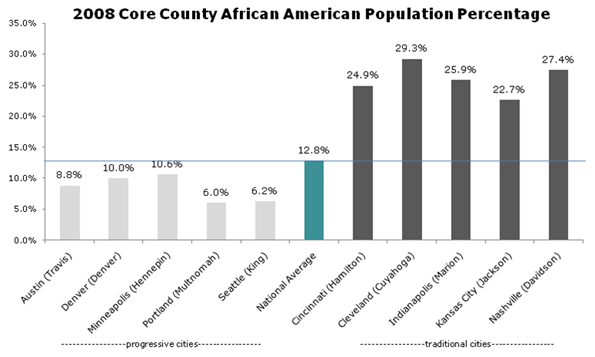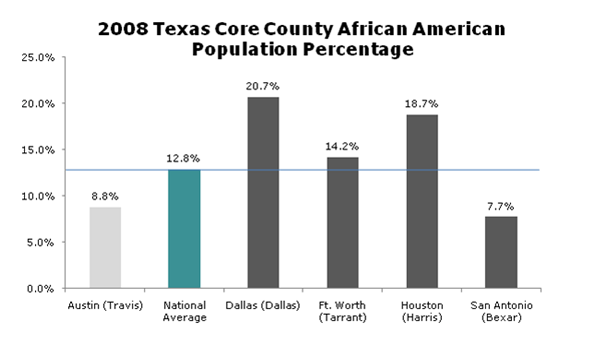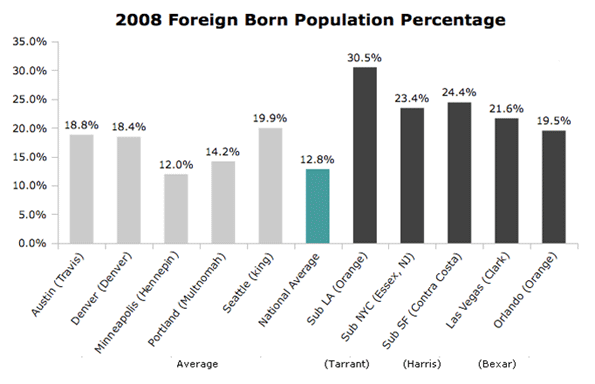
Among the media, academia and within planning circles, there’s a generally standing answer to the question of what cities are the best, the most progressive and best role models for small and mid-sized cities. The standard list includes Portland, Seattle, Austin, Minneapolis, and Denver. In particular, Portland is held up as a paradigm, with its urban growth boundary, extensive transit system, excellent cycling culture, and a pro-density policy. These cities are frequently contrasted with those of the Rust Belt and South, which are found wanting, often even by locals, as “cool” urban places.
But look closely at these exemplars and a curious fact emerges. If you take away the dominant Tier One cities like New York, Chicago and Los Angeles you will find that the “progressive” cities aren’t red or blue, but another color entirely: white.
In fact, not one of these “progressive” cities even reaches the national average for African American percentage population in its core county. Perhaps not progressiveness but whiteness is the defining characteristic of the group.

The progressive paragon of Portland is the whitest on the list, with an African American population less than half the national average. It is America's ultimate White City. The contrast with other, supposedly less advanced cities is stark.
It is not just a regional thing, either. Even look just within the state of Texas, where Austin is held up as a bastion of right thinking urbanism next to sprawlvilles like Dallas-Ft. Worth and Houston.

Again, we see that Austin is far whiter than either Dallas-Ft. Worth or Houston.
This raises troubling questions about these cities. Why is it that progressivism in smaller metros is so often associated with low numbers of African Americans? Can you have a progressive city properly so-called with only a disproportionate handful of African Americans in it? In addition, why has no one called these cities on it?
As the college educated flock to these progressive El Dorados, many factors are cited as reasons: transit systems, density, bike lanes, walkable communities, robust art and cultural scenes. But another way to look at it is simply as White Flight writ large. Why move to the suburbs of your stodgy Midwest city to escape African Americans and get criticized for it when you can move to Portland and actually be praised as progressive, urban and hip? Many of the policies of Portland are not that dissimilar from those of upscale suburbs in their effects. Urban growth boundaries and other mechanisms raise land prices and render housing less affordable exactly the same as large lot zoning and building codes that mandate brick and other expensive materials do. They both contribute to reducing housing affordability for historically disadvantaged communities. Just like the most exclusive suburbs.
This lack of racial diversity helps explain why urban boosters focus increasingly on international immigration as a diversity measure. Minneapolis, Portland and Austin do have more foreign born than African Americans, and do better than Rust Belt cities on that metric, but that's a low hurdle to jump. They lack the diversity of a Miami, Houston, Los Angeles or a host of other unheralded towns from the Texas border to Las Vegas and Orlando. They even have far fewer foreign born residents than many suburban counties of America's major cities.

The relative lack of diversity in places like Portland raises some tough questions the perennially PC urban boosters might not want to answer. For example, how can a city define itself as diverse or progressive while lacking in African Americans, the traditional sine qua non of diversity, and often in immigrants as well?
Imagine a large corporation with a workforce whose African American percentage far lagged its industry peers, sans any apparent concern, and without a credible action plan to remediate it. Would such a corporation be viewed as a progressive firm and employer? The answer is obvious. Yet the same situation in major cities yields a different answer. Curious.
In fact, lack of ethnic diversity may have much to do with what allows these places to be “progressive”. It's easy to have Scandinavian policies if you have Scandinavian demographics. Minneapolis-St. Paul, of course, is notable in its Scandinavian heritage; Seattle and Portland received much of their initial migrants from the northern tier of America, which has always been heavily Germanic and Scandinavian.
In comparison to the great cities of the Rust Belt, the Northeast, California and Texas, these cities have relatively homogenous populations. Lack of diversity in culture makes it far easier to implement “progressive” policies that cater to populations with similar values; much the same can be seen in such celebrated urban model cultures in the Netherlands and Scandinavia. Their relative wealth also leads to a natural adoption of the default strategy of the upscale suburb: the nicest stuff for the people with the most money. It is much more difficult when you have more racially and economically diverse populations with different needs, interests, and desires to reconcile.
In contrast, the starker part of racial history in America has been one of the defining elements of the history of the cities of the Northeast, Midwest, and South. Slavery and Jim Crow led to the Great Migration to the industrial North, which broke the old ethnic machine urban consensus there. Civil rights struggles, fair housing, affirmative action, school integration and busing, riots, red lining, block busting, public housing, the emergence of black political leaders – especially mayors – prompted white flight and the associated disinvestment, leading to the decline of urban schools and neighborhoods.
There's a long, depressing history here.
In Texas, California, and south Florida a somewhat similar, if less stark, pattern has occurred with largely Latino immigration. This can be seen in the evolution of Miami, Los Angeles, and increasingly Houston, San Antonio and Dallas. Just like African-Americans, Latino immigrants also are disproportionately poor and often have different site priorities and sensibilities than upscale whites.
This may explain why most of the smaller cities of the Midwest and South have not proven amenable to replicating the policies of Portland. Most Midwest advocates of, for example, rail transit, have tried to simply transplant the Portland solution to their city without thinking about the local context in terms of system goals and design, and how to sell it. Civic leaders in city after city duly make their pilgrimage to Denver or Portland to check out shiny new transit systems, but the resulting videos of smiling yuppies and happy hipsters are not likely to impress anyone over at the local NAACP or in the barrios.
We are seeing this script played out in Cincinnati presently, where an odd coalition of African Americans and anti-tax Republicans has formed to try to stop a streetcar system. Streetcar advocates imported Portland's solution and arguments to Cincinnati without thinking hard enough to make the case for how it would benefit the whole community.
That's not to let these other cities off the hook. Most of them have let their urban cores decay. Almost without exception, they have done nothing to engage with their African American populations. If people really believe what they say about diversity being a source of strength, why not act like it? I believe that cities that start taking their African American and other minority communities seriously, seeing them as a pillar of civic growth, will reap big dividends and distinguish themselves in the marketplace.
This trail has been blazed not by the “progressive” paragons but by places like Atlanta, Dallas and Houston. Atlanta, long known as one of America's premier African American cities, has boomed to become the capital of the New South. It should come as no surprise that good for African Americans has meant good for whites too. Similarly, Houston took in tens of thousands of mostly poor and overwhelmingly African American refugees from Hurricane Katrina. Houston, a booming metro and emerging world city, rolled out the welcome mat for them – and for Latinos, Asians and other newcomers. They see these people as possessing talent worth having.
This history and resulting political dynamic could not be more different from what happened in Portland and its “progressive” brethren. These cities have never been black, and may never be predominately Latino. Perhaps they cannot be blamed for this but they certainly should not be self-congratulatory about it or feel superior about the urban policies a lack of diversity has enabled.
Aaron M. Renn is an independent writer on urban affairs based in the Midwest. His writings appear at The Urbanophile.













The idea that people move to
The idea that people move to Portland to get away from litter, graffiti, teenage mothers yelling at babies, break-ins and violence is way too simplistic. Portland has all of that - There are plenty of falling down porches with soggy couches on them/plastic wrap on windows. You'll be asked for money on every single corner and off ramp downtown. Witness drug deals on the train, in the parks, on the streets. See gang tags all over buildings, fences, poles. I've lived here for 15 years, my house has been broken into while I was on a walk around the corner to get a bite to eat. You bet I look over my shoulder when I'm walking around. Portland shouldn't be held up on a pedestal or romanticized....but you won't read that in a visitor's guide.
That said, perhaps there is less of these elements than in a "huge dangerous ghetto" but to imply that it isn't here in Portland - and not a problem - is simply not true.
Exactly right
This is exactly right. Also, you see this same behavior in Scandinavian and European countries, though towards Muslim immigrants who come over and promptly begin stoning their teenage daughters for having premarital sex. Also, for the record, this is not something that people need to be “called out” on.
I do agree with the premise of this article, though and am glad to see it brought to light even if I don't take the same moral offense to what these numbers suggest (no matter how disputed they've been in the comments section).
Another Comment
I might add that even if Portland is predominately "white" (by the definition of race, not ethnicity) it nonetheless has much more racial integration in regards to available data.
Cleveland's core county has about 1.5% of its population identifying as two or more races, with African-American/black and white race mix representing 0.6% of the total "two or more" race population.
Meanwhile, Portland's core county has about 4.3% of the population identifying as two or more races from recent census data, of which 1% are black/white mix.
Both numbers are low, but based off the fact that Portland barely has above 5.5% black-only population, I find that statistic amazing. Think about how profound that is. Cleveland has almost 30% black population, yet Portland has a higher percentage of black/white mixed people! You'd think that at some point a black person and a white person might meet in Cleveland (they are the two largest races there). I've never lived there, but the data about the core county speaks volumes.
Speaking of Cleveland, Portland has about about 14% foreign born population vs. Cleveland's 7%. This is key, because racially, Hispanic and Latino ethnicity is considered "white", of which Portland has way more than the Rust Belt. About 10% of total population identify as Hispanic/Latino in Multnomah county.
I think this goes to show you're viewing this issue from a black and white perspective, and not an ethnic/international lens.
Are you really sure these Midwest cities are truly anymore diverse than the so called "progressive" cities? I thought this was an interesting article at first glance, but now I think it's more of the same anti-smart growth mantra that gets thrown around on this site.
ACS Census:
Cleveland:
http://factfinder.census.gov/servlet/ADPTable?_bm=y&-context=adp&-qr_nam...
Portland:
http://factfinder.census.gov/servlet/ADPTable?_bm=y&-geo_id=05000US41051...
There is no doubt that Rust
There is no doubt that Rust Belt cities generally have very low levels of foreign-born residents. No argument there.
my take on it
you wrote, "why has no one called these cities on it?". who are you going to call? can you just call up some whites and blacks and ask em? a silly premise deserves a silly question back.
when i moved here it was not to "run away" from blacks. your article has a strange premise. it reminds me of someone who gathers statistics and then makes conclusions from them based on their own ideas. remember the stat that most wrecks happen within 2 miles of your own home/residence? people assumed that meant that people drive worse near their home and came up with other theories, actually it was that you spend more time driving near you own home so you are more likely to have a wreck.
this article reminds me of that-the two are not really related, the progressiveness and the lack of blacks and as far as "why has no one called these cities on it?". Maybe it is because we are calling ourselves on it already? We have several African American Quality of Life Initiatives in the past several years and several Hispanic Quality of Life initiatives as well. The public were invited to come and comment on what is needed in Austin to keep and attract more Blacks & Hispanics. Maybe if you get a few more black friends in Austin-you can ask them yourself.
the creepy texan
shortsighted analysis
"Again, we see that Austin is far whiter than either Dallas-Ft. Worth or Houston."
Not exactly ... what we do see is Austin is less black than either Dallas-Ft. Worth or Houston.
Instead, Austin is actually a "majority-minority" city.
A quick google search reveals this document from the City of Austin:
http://www.ci.austin.tx.us/demographics/
(click on "Top ten demographic trends in Austin")
"The City of Austin has now crossed the threshold of becoming a Majority-Minority city. Put another way, no ethnic or demographic group exists as a majority of the city’s population. The city’s Anglo share of total population has dropped below 50% (which probably occurred sometime during 2005) and will stay there for the foreseeable future."
Surely you knew that not everyone in Austin is either "black" or "white"?
Are you talking about inside
Are you talking about inside the city limits? Again, for the reasons I outlined in my comment above, I don't think this is the best method for comparing data across cities. But thanks for the additional insights into demographic trends in Austin.
Very interesting
Just found you via Rod Dreher. I look forward to reading more here, but have to comment on the data presented in this post. I see lots of problems. Using the core county as your source of racial data to analyze is very distorting. The 3 cities I am most familiar with, Portland, Seattle and Minneapolis, are all much higher minority than the surrounding very large county. I would guess county size negatively correlates with minority population.
However, the much bigger problem is representing non-black as white. "African Americans, the traditional sine qua non of diversity" is a tradition that needs to be buried. Your nationwide analysis only shows regional differences in the largest non-white category. Asians in the northwest, Hispanics in the southwest, blacks in the rust belt and south. As for Texas, get the data for city limits only and show non-Hispanic whites, not one minority group, then let's look at it.
The analysis of the data isn't any better, unfortunately. It has too many issues to address, but one stands out for me. As a Norwegian-American from Minneapolis, I have to decline the credit for our progressive policies on behalf of my fellow Scandinavians. The original power brokers of the Twin Cities were as WASPy as most other American big cities - which is to say, very WASPy. And while white is considered homogeneous today, back in the day WASPs, Germans, Scandinavians, Irish, Central Europeans, Jews, Eastern and Southern Europeans would never put themselves into a category with any of the other groups. Scandinavians do seem to have played an out-sized role in the area's history, but that is only anecdotal. Their numbers never came close to half of the population, I would bet. And that lumps them all together, something Norwegians and Swedes, for instance, wouldn't accept to until relatively recently.
http://norwegianshooter.blogspot.com
Comparisons between cities
Comparisons between cities are inherently difficult. I generally do not like to use central city corporate limit data as a basis for comparison because the size of central cities is so different. Indianapolis and Columbus are both large because they annexed large amounts of "suburban" territory, while Cincinnati and Cleveland did not and are much smaller geographically. To compare across cities, I have generally found that it is better to use the core county as a proxy for the central city in most cases since it more normalizes geographic scope. (MSA is probably the best comparator for regions). This isn't perfect either. Denver County is really a county around a smaller central city. St. Louis is an independent city. But I think it is probably the best way to go.
Thanks for the history on Minneapolis.
Denver
For the record, Denver County is not a county around a smaller central city. City and County of Denver are coterminous.